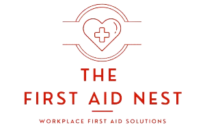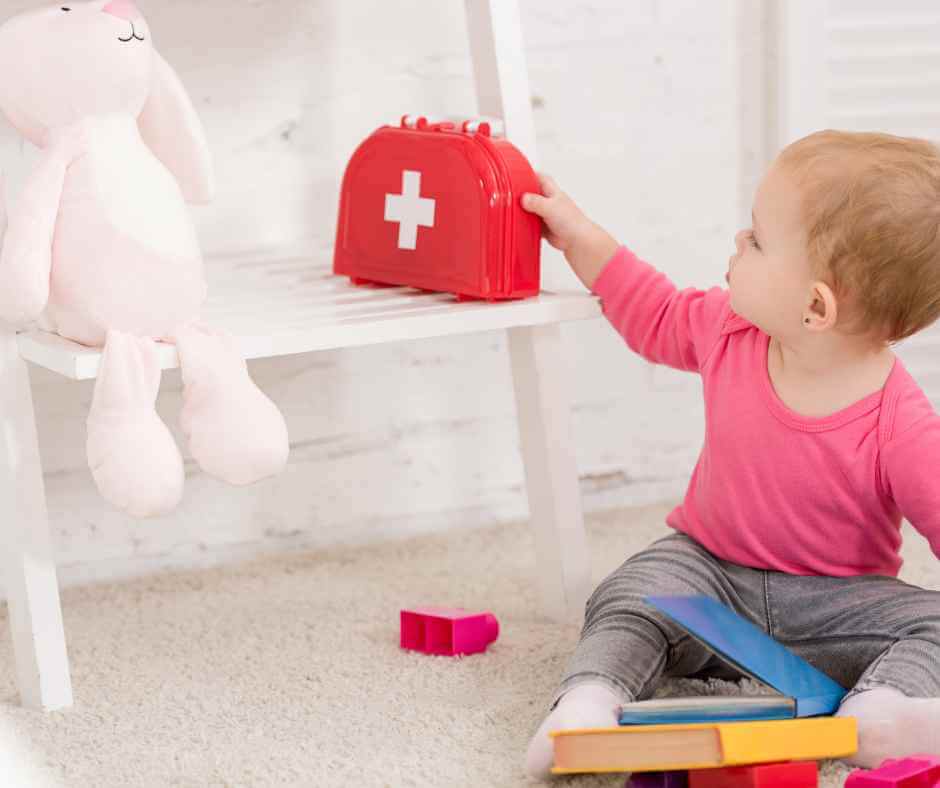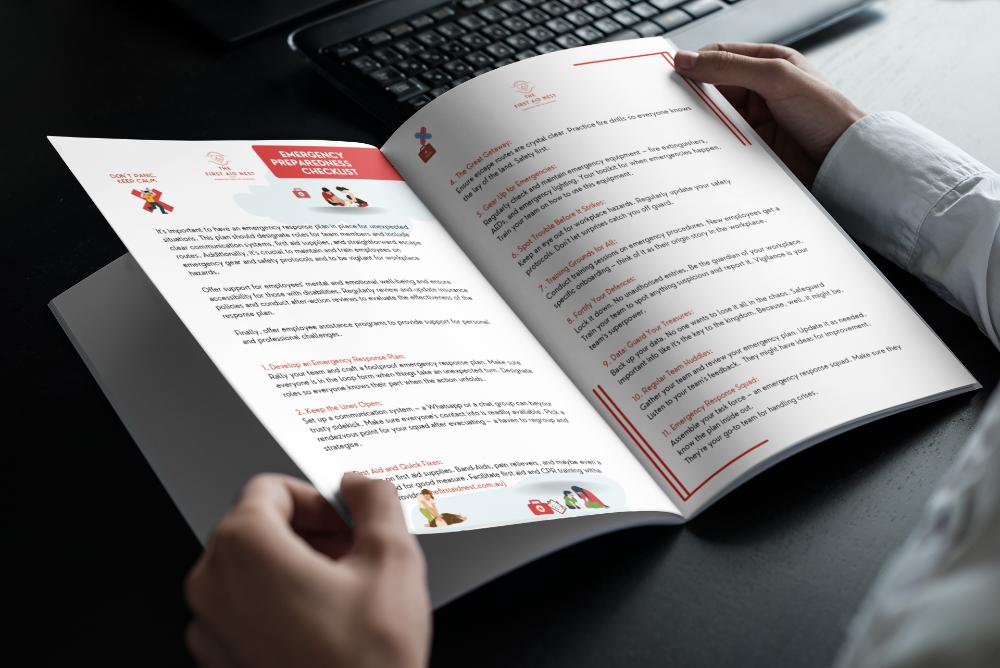A First Aid Kit From Home For Your Baby

Let’s talk about First Aid supplies in your home for your baby and small child.
We take a look at some items that are necessary in case of an emergency and list the items you can use to make your own first aid kit at home. Although first aid kits are very handy and have a lot of specific items in for your small child, we also believe you already have a few items in your house!
The first aid kits that you can buy ready-made in shops are great, but it doesnt hurt to add your own bits and pieces that may also fit in your nappy bag!
For a basic first aid kit suitable for small children for emergency situations, we suggest the following:
- Sanitary Towels – these are really handy for any kind of bleeding since they are designed to capture heavy blood loss and work really well for head injuries and nose bleeds. They can be strapped on with tape or a small bandage. They are very effective and largely underlooked. A nappy would do the same job!
- Cold pack – no children’s first aid kit would be complete with a cold pack to tackle those bumps and bruises! These can also be effective on suspected fractures. Be mindful to cover the pack with a light sheet or face cloth if it feels too cold to touch for a young child.
- Clean Towels and Linen – anything to mop up spills and blood. Or can be used to keep someone comfortable, or to cover a wound / open fracture. Different size face cloths and tea towels could also be useful for small children.
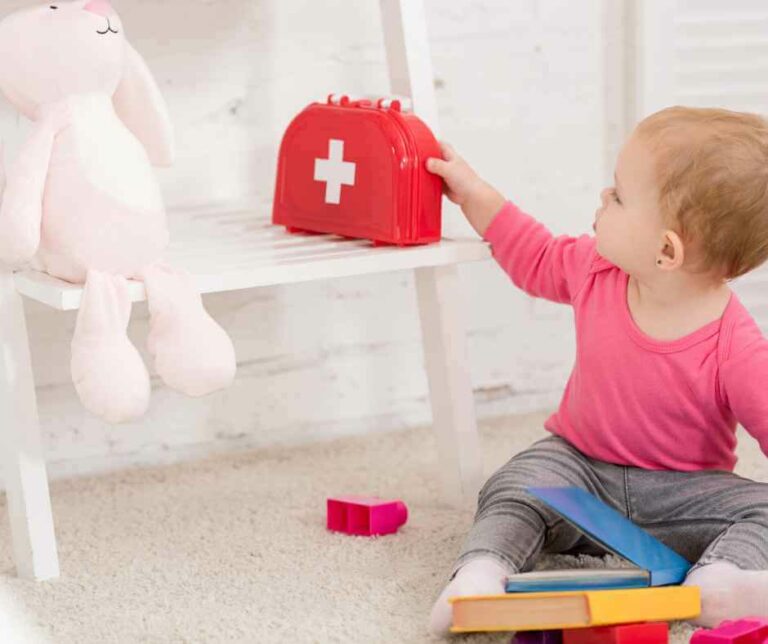
- Tape – any tape will work – it can be normal sticky tape or electrical tape. It is used to keep something in place, for example, cling film on a burn wound, or a sanitary towel until you get help.
- Cling Film – used for burns (we also discuss this extensively in our classes). There are many different reasons we use cling film for burns. If you use cling film to cover a burn, you must seek help within the hour as the clingfilm should not be left in place any longer than that.
- It is non-stick, so when removed it will not cause anymore trauma to the site
- It covers the burn and creates a barrier to the oxygen, which in turn helps to reduce the pain
- It still gives you visibility of the burn as it is transparent
- It creates a barrier to help reduce the risk of infection
- Bandages – if you do not have this in your home, you can get this at any chemist. We suggest two or three different sizes. Bandages can be used for keeping a dressing in place or could also be fashioned into a sling for a suspected fractured arm. We would also use a bandage for PIT after a venomous bite from a snake, cone shell snail or blue ring octopus. PIT is Pressure Immobilisation Technique. You will learn this in most first aid classes.
- Soap – unscented soap for cleaning out wounds (don’t underestimate the power of normal hand soap). Make sure it is not perfumed as this could irritate an injury and make the pain worse. Some wounds if deep, bleeding profusely or particularly painful may not be suitable for washing, however grazes with foreign material in may be gently washed.
- Muslin – any large, square muslin, which can be used to create a triangular bandage for slings. You will need to fold the muslin into a triangle. Just keep folding into a smaller triangle until you get the desired size. Always place the point of the triangle under the affected elbow, then place the ends of the triangle over each shoulder. Tie the muslin behind the neck and try to have the arm elevated as high as you can to reduce swelling which in turn reduces pain.
- Lollipop Sticks / Wooden Spoons – can be used to support an arm or a finger that has been misshapen. They are very effective as a splint. You would place the object next to the affected arm or finger and just gently wind a bandage round to support the area, if a sling was not possible. You can also use a rolled up magazine as a splint as they are hard to bend!
- Thermometer – A small digital thermometer is sufficient for a small child. There are brands that can be used for under the arm. These are called axilla thermometers. Remember that anything above 38 degrees is a fever. The number on the thermometer does not correlate to the severity of the illness. If your baby is under 3 months old and their temperature is above 38 degrees, you must seek medical attention immediately.
A first aid kit for home should also include some age appropriate medicines for your baby or small child.
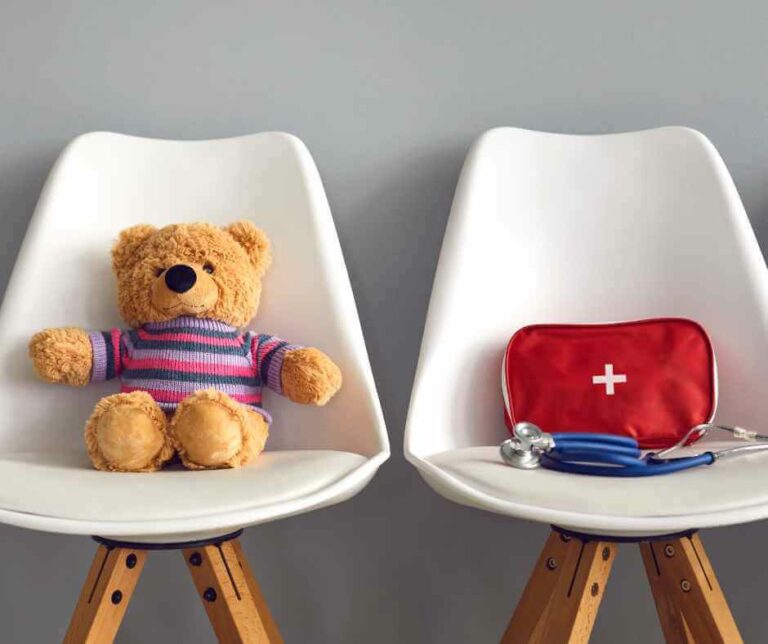
- Medicines – A baby first aid kit should include some medications appropriate for age, which could include the following.
- Paracetamol – this is good for pain relief and reducing fever
- Ibuprofen – this is used for pain relief, reducing fever and reducing swelling
- Antihistamine – this can be used for bites, stings and any allergy symptoms or hives.
- Bandaids – No first aid kit is complete with some bandaids. Preferably the ones with cartoon characters, it always makes the cut hurt less!
- Plastic bag – Essential to either catch vomit or place items that have been used to mop up blood.
- Antiseptic wipes and hand rub – This item speaks for itself. It is essential to keep the area clean to avoid any infection. But don’t put alcohol wipes or hand rub directly onto an open wound, this would be extremely painful! Just clean around the area, and clean any equipment including your hands.
First Aid Kit for Baby and Child
These supplies will be mostly helpful for any kind of scrapes, bruises, dislocations, burns and bleedings, and remember it is just for immediate first aid, remember to always seek medical attention if you are worried about your child.
Want more? We’ve got you covered…
Our Baby First Aid Courses
Our baby first aid courses are available in person in your home and online. We run classes in your home with groups of 2, 4 or up to 10 in Sydney & Melbourne and you can book in 3 easy steps!
- Pick your class
- Follow the prompts to purchase
- We will contact you within 24 hours to lock in your date of choice
Our First Aid Certificate Courses
We run most of the popular first aid courses Australia wide. HLTAID011 Provide First Aid, HLTAID009 Provide CPR, HLTAID012 Provide First Aid in an Education & Care Setting, RAMOAP (anaphylaxis), Mental Health first aid and CPR/LVR to name a few.
Book your public spot online or contact us if you have a group of 5+ people for onsite training.
Here are some other resources you may enjoy!
FREE GUIDE: Your Virtual Baby First Aid Kit
FREE GUIDE: Introducing Common Allergy Foods & Allergic Reactions
FREE Workplace Emergency Preparedness Plan: Grab this at the bottom of every page!
Follow for baby & child first aid and allergy info and tips on Instagram, TikTok & Facebook all @thenestcpr
